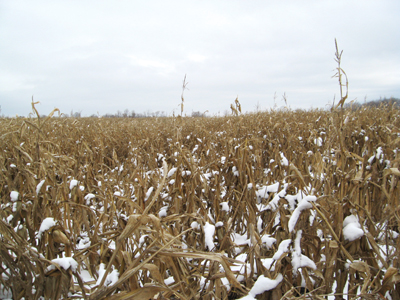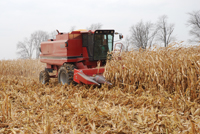
Features
Agronomy
Harvesting
Will field drying corn save money?
In the fall of 2009, many farmers had to decide whether to harvest high-moisture corn and pay the extra drying costs or to delay harvest to allow field drying. For growers facing that decision in the future, here are two approaches, one quantitative and the other qualitative, to help assess the options.
February 25, 2010 By Carolyn King
 |
| Poor standability and bad weather can produce high yield losses in corn crops left to dry in the field.
Photo courtesy of Robert Moloney.
|
In the fall of 2009, many farmers had to decide whether to harvest high-moisture corn and pay the extra drying costs or to delay harvest to allow field drying. For growers facing that decision in the future, here are two approaches, one quantitative and the other qualitative, to help assess the options.
Calculating the break-even point
Robert Moloney, an agronomist with NK Seeds/Syngenta, recommends that growers take a hard look at the costs when deciding whether to delay harvest. In a recent issue of Crop Barometer, he uses a simplified equation, developed by Dr. Paul Carter of the University of Wisconsin, to determine the break-even yield loss. That is the maximum number of bushels per acre a grower could afford to lose during field drying before it becomes cheaper to harvest when the crop is mature and pay for the extra drying.
Moloney works through an example to show that the calculation is not quite as agonizing as one might think. “Let’s say your corn is at 35 percent moisture, and if you harvest now you’ll get 150 bu/ac,” he explains. “You’re considering whether to harvest it now or leave it in the field until next spring when it’s at 16 percent moisture.”
The cost to dry corn at an elevator is $0.04 per percentage point of moisture per bushel, so the cost to dry corn from 35 percent to 16 percent would be (35-16) x $0.04 = $0.76 per bushel. So the drying cost per acre would be: 150 bu/ac x $0.76/bu = $114.00/ac.
If the price of corn is $4.00/bu, then that $114.00/ac cost would be equivalent to ($114.00/ac ÷ $4.00/bu) = 28.5 bu/ac of corn, which would be a 19 percent yield loss (28.5 bu/ac ÷ 150 bu/ac x 100).
So if a grower lets the corn field dry, and if the yield loss from field drying is less than 28.5 bu/ac, then the grower comes out ahead. But if the yield loss is more than 28.5 bu/ac, then it would have been less costly to harvest the corn at 35 percent moisture and pay for drying.
A grower performing this calculation with his own numbers will indicate the costs he is facing; however, he still needs to evaluate the risk of whether he will exceed the break-even yield loss.
Weighing the risks
The key factor to consider is standability. “If you’ve got stalk rot and you get a couple of big wind storms and/or a big wind with heavy, wet snow, that can pull the whole stalk down. It doesn’t take long to reach a yield loss of 10 percent if you start losing plants that can’t get picked up by the combine,” says Moloney.
A grower can check standability using a pinch test or a push test.
Another consideration for growers is how long the corn might have to be left in the field to achieve a preset moisture level: Is it a few weeks or all winter? The longer the harvest is delayed, the greater the risk of loss, especially in or on the edge of areas that are prone to windy or snowy conditions, or if warm, wet weather causes ear moulds. Moloney notes, “If your corn already has some ear mould, it’s best to harvest and dry it as soon as possible to stop mould growth and possible toxin production.”
Moloney adds that, in southern Ontario under good drying conditions, corn moisture content might drop about 0.5 percent per day in early fall while the weather is still warm and perhaps 0.25 percent per day in late fall. But the drying rate can vary greatly depending on the weather and the corn’s maturity and condition. “The primary way corn gets down to harvest moisture is that, as it matures, it fills the kernel with starch, which physically pushes the moisture out of the kernel,” explains Moloney. He says that in 2009, some parts of southern Ontario got an early frost before the corn was fully mature. As a result, the kernels did not completely fill with starch, so they tended to have higher moisture and to take longer to field dry.
He adds, “The other issue in 2009 was that the corn husks tended to stay very tight. Quite often by December, the husks have loosened up enough to allow air movement to get the moisture out. But this fall they stayed tight so the kernels haven’t lost as much moisture as usual.”
A grower who decides to harvest very moist, immature corn can run into other problems. “You usually store corn at about 15 percent moisture, so normally you would dry it to about 13 or 14 percent knowing that it’s probably going to bounce back to 15 percent and a bit, as moisture in the very middle of the kernel migrates to the outside. But if the corn hasn’t fully matured and is really wet to begin with, it will tend to have a big bounce-back factor,” says Moloney. “You can dry it down to 13 or 14 percent, but it can bounce back way above 15 percent because it’s not easy to remove the moisture trapped in the very centre of that kernel.“ Another challenge with lower quality corn is the high potential for fracturing and breakage of kernels rapidly cooled after high-temperature drying. Higher temperatures can increase dryer throughput with higher moisture corn, but it’s a trade-off with potentially causing more quality issues.
 |
| Whether harvesting in the fall or the spring, growers must assess their own break-even yield loss.
Photo by Ralph Pearce.
|
To calculate or not to calculate
Moloney advises growers to check the numbers before deciding whether to delay corn harvest. “It hurts to have to pay megabucks to get corn dried, but you really should look at your field’s standability and offset that with what it’s going to cost you to dry it.”
For those who feel profound sleepiness washing over them when the talk turns to equations, there is another option. Greg Stewart, corn specialist with the Ontario Ministry of Agriculture, Food and Rural Affairs, offers a qualitative approach. He notes, “Sure, you can calculate what the savings will be if, for instance, you’re at 28 percent now and you leave the corn till it’s 16 percent in March. But the yield loss side of it is much more iffy. Is it going to be a 10 percent yield loss or a 35 percent yield loss? Other than evaluating standability, it’s almost impossible to say for sure how much you’re going to lose over
the winter.”
In a recent issue of the CropPest Ontario, Stewart provides seven questions to help evaluate the situation:
Standability: Evaluate stalk strength using a pinch or pull test. Does the test show the stalks are weak or suspect?
Snow load: Is the farm in an area where snow load is often significant?
Crop insurance: Has the harvest to date already put a grower over the guaranteed production level?
Crop quality: Can the crop be harvested mid-winter and get corn that is Grade 4 or better?
Corn moisture: Is the corn moisture less than 35 percent?
Drying charges: Is the corn drying done on-farm, rather than off-farm?
Soil conditions: Can harvesting be done without rutting the soil?
If the answer to most of these questions is “yes,” then harvesting right away is probably best. If the answer is “no” to most of them, then delaying harvest may make more sense.
Stewart adds, “If your answers line up in favour of harvesting now, then you probably wouldn’t consider leaving your crop out regardless of what you thought the economics might be. And, similarly, if your answers all lean in favour of leaving your corn out, you probably will.”
A tip for next fall: Checking standability
Growers can check corn standability with a pinch test, squeezing the stalk to see if it has weak spots, or a push test, pushing on the plant to see if it lodges.
Moloney describes how to do the push test. “Randomly select 20 plants from five different areas of the field, for a total of 100 plants. Then push the top portion of each plant, just above the ear, six to eight inches from the vertical. Note the number of plants that break and whether the break occurs above or below the ear,” he explains. “The number of plants that break is the percentage of plants at risk of breakage if the crop is left in the field. If the break occurs above the ear, it may slow harvest but shouldn’t cause yield loss. If it occurs below the ear you may have yield loss if you can’t get the ear into the combine.”
Moloney adds, “While you are doing the test, split some stalks to see if the weakness is due to stalk rot, which could get worse if the weather is warm. The centre of a healthy stalk will be a bright white. Stalk rots cause the centre to be off-white, pink, brown, depending on the type of rot.”
If there is a standability problem with more than about 10 to 15
percent of the plants, consider harvesting earlier rather than later.
| A tip for the winter: Watch the bins Moloney cautions, “Anyone who is storing corn on-farm this year needs to keep a super-close eye on it. There are so many fines and other junk in the bin that a lot of corn will spoil if farmers are not right on top of managing what they have in the bin.” He says the 2009 corn harvest in many parts of Ontario was “beyond ugly” for fine particles; lots of kernel damage occurred during combining because the corn was so soft. “And every time you move it, every time it goes through an auger or does anything, just makes it that much worse.” Those fine particles tend to end up in the centre of the bin. They clog up the spaces between the kernels so the air cannot move around the kernels. Consequently the kernels do not dry down properly, and problems like mould and insect damage can result. Moloney states, “This year I’ve heard of guys who took the core out but weren’t happy with the results. They damaged that much more corn coming out of the bin, cleaning it and putting it back in the bin, that they ended up not much better off.” |